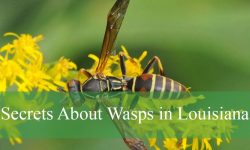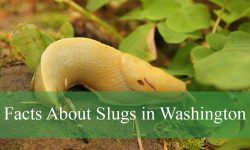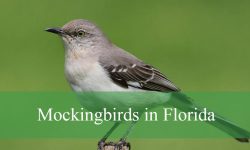We love spending more time in the yards, parks, and forests when the weather starts to warm up. You might encounter creepy crawling insects that bite or sting while relaxing in this environment.
Many people blame flying insects or poisonous plants for a skin ailment after visiting a park or woodland forest. But we recommend considering stinging caterpillars before concluding about the latter.
Common types of stinging caterpillars are rose caterpillar, lo moth caterpillar, spiny elm caterpillar, white flannel moth caterpillar, southern flannel moth caterpillar, and white-marked tussock caterpillar.
Identifying these stinging crawling creatures can be a challenging and intimidating experience. Most caterpillar species are venomous and cause damage to plant leaves in your garden.
We wrote this detailed guide to help identify different kinds of stinging caterpillars in your home and garden. Do not handle these caterpillars with your hands since they can cause nasty stings similar to a wasp’s sting.
Are Stinging Caterpillars Poisonous?
Stinging caterpillars have hollow quill-like hairs connected to venomous glands in their bodies. When these hairs are touched, they will pierce the skin and release a poison that causes a severe effect.
Common symptoms of stings from caterpillars are localized pain, swelling, blistering, rashes, and intestinal disturbance if ingested. But these stinging caterpillars are not aggressive to humans and pets. (Source: University of Kentucky).
We recommend sticking a piece of tape to the affected area and peeling it off to remove the quills stuck in your skin. However, this home remedy is less effective since you will still experience mild to severe pain.
Washing the area with medicinal soap and water will help remove the venom. Be sure to apply baking soda to reduce the pain and swelling. If your toddler or dog ingests the caterpillar, we recommend seeking immediate medical attention.
Spray your backyard plants to avoid heavy infestation and foliage destruction. Another option is to hire a pest control and Management Company to help get rid of stinging caterpillars in your home.
Different Types of Stinging Caterpillars
Identifying different stinging caterpillars can be a daunting experience for gardeners with limited knowledge of entomology. Below is a list of 20 types of stinging caterpillars with pictures and names:
Stinging Rose Caterpillar
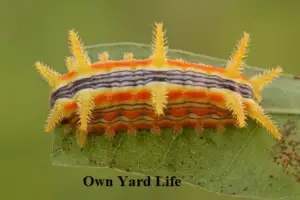
It is the most beautiful stinging caterpillar due to its vibrant colors. But refrain from handling the grub since it can cause itchy and irritating rashes on your skin. The bright yellow spines sticking out of the body are the distinctive features.
Other prominent features are the spiky horns along the sides, front, and rear. Other stinging rose caterpillars have red-colored bodies with rows of purple or black stripes along their backs.
Yellow stinging rose caterpillars with white and blue stripes are common in Florida, Texas, Oklahoma, and the Eastern States of the US. These stinging grubs love feeding on apples, hickory, oaks, and maples.
Scientific Name |
Parasa indetermina |
Host Plants |
Apple, dogwood, oak, maple, hickory, and rose bushes. |
Identification Features |
A cluster of spiny horns covering its yellow to green to a red soft body. |
What They Turn Into |
Rose moth with green patches on the forewings. |
Io Moth Caterpillar
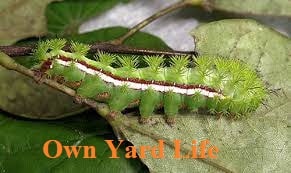
It is a caterpillar covered with protruding light green spikes containing toxic substances that cause skin-level allergy. Refrain from rubbing against these grubs to avoid throbbing pain, swellings, and skin rashes.
Juvenile lo moth caterpillars look like orange worms before turning lime-green in the instars approaching pupation. The red and white stripes along the sides are distinctive features for easy identification.
These stinging caterpillars feed on the leaves of willow, hackberry, redbud, blackberry, and pears. Use chemical treatments or pesticides to eliminate these grubs from your ornamental trees.
Scientific Name |
Automeris io |
Host Plants |
Willow, hackberry, redbud, blackberry, and pears |
Identification Features |
Green body with protruding light green spikes |
What They Turn Into |
Yellow-brown moth with prominent hindwing eyespots. |
Spiny Elm Caterpillar
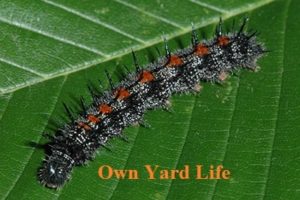
It is a spiny black caterpillar that turns into a beautiful mourning cloak butterfly. The grub can grow up to 2 inches long and stink when your skin rubs against spines. We recommend not handling them without protective gear.
The row of bright red or orange dots on its back and the jet-black line running along the back are the distinctive features for identifying spiny elm grubs. A cluster of white freckles also covers the black segments and makes the red prolegs visible.
These caterpillars with sharp-looking black spines feed on the leaves of elm, poplar, and willow trees. After pupation, they turn into velvety black butterflies with raised white and red dots on the mid-dorsal area.
Scientific Name |
Nymphalis antiopa |
Host Plants |
Elm, poplar, and willow |
Identification Features |
Long black and white caterpillar with red spots and a spiky fuzzy appearance |
What They Turn Into |
Velvety black butterfly with raised white dots and red spots row on the mid-dorsal region. |
White Flannel Moth Caterpillar
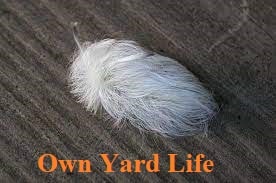
This fuzzy stinging caterpillar comes in a multicolored variation with long wispy hairs and tufts of stinging spines. Refrain from rubbing your skin against these caterpillars to avoid a burning sensation and skin irritation.
The popular colors for these flannel moth caterpillars are black, yellow, and brown. The wide black stripe on the central segment and brown-colored tips are the distinctive features for identifying these grubs.
The venomous spines can cause nasty stings that may require medical attention. These white flannel moth caterpillars are native to Washington DC, Texas, Arizona, and Florida or Mexico and Southern America.
Scientific Name |
Norape ovina |
Host Plants |
Black locust, elm, greenbrier, and hackberry. |
Identification Features |
Yellow dots covering the back |
What They Turn Into |
Hairy white moth |
Southern Flannel Moth (Asp) Caterpillar
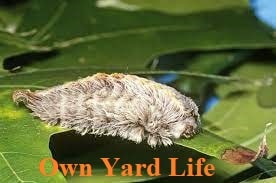
It is the most toxic stinging caterpillar also known as the woolly slug, Italian asp, and puss moth caterpillar. The nasty bite from these caterpillars is as painful as snake ones. Be sure to refrain from rubbing your skin against them while in the park or yard.
The southern flannel moth caterpillars’ color range from grey-white to dark brown and almost jet-black. These grubs hail from the Southern regions of the US and can defoliate your backyard trees or crops.
These furry caterpillars may appear deceiving due to their soft fur that conceals sharp stinging spines. They grow up to an inch long and turn from a dull orange to a lemon-yellow moth after pupation.
Scientific Name |
Megalopyge opercularis |
Host Plants |
Almond, apple, hackberry, oaks, orange, pecan, persimmon, and roses |
Identification Features |
A fluffy mound of fur and distinct tail |
What They Turn Into |
White-Marked Tussock Caterpillar
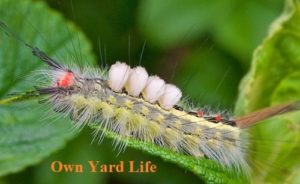
White-marked tussock caterpillar has a unique appearance with stinging hairs and dwells in gardens, parks, and woodland forests. These segmented caterpillars have black and yellow stripes along their sides.
The red spots around the body with four white tufts of hair are the distinctive features for identifying these stinging caterpillars. Other features are the long black tails on either side with prominent defensive glands.
Fine hairs can cause skin irritation or allergic reactions when they rub against your body. Avoid touching these caterpillars without wearing protective gear. These grubs love feeding on tree leaves of cherry, oak, elm, spruce, and apple.
Scientific Name |
Orgyia leucostygma |
Host Plants |
Apple, dogwood, hackberry, plums, pears, oaks, poplars, redbud, roses, and walnut. |
Identification Features |
Bright colors and unusual tufts of hairs |
What They Turn Into |
Dusty white moths |
Saddleback Caterpillar
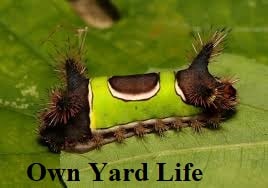
It is an anger-looking caterpillar to scare away potential predators and humans. The slug-type caterpillar has spiny horns that sting when they rub against the skin. Do not touch these caterpillars without wearing protective gear.
The saddle-like marking on the back and a large brown dot in the middle are the distinctive features for identifying saddleback caterpillars. The grub has two white dots looking like menacing eyes at the end.
The urticating spines on the body and horns can give a nasty sting. The venom might cause throbbing pain and skin rashes. Severe stings can result in nausea and might need medical intervention.
Scientific Name |
Acharia stimulea |
Host Plants |
Apples, Asters, blueberries, citrus, corn, dogwood, elms, grapes, maples, and oaks |
Identification Features |
Saddle markings on the back and tufts of the spine along the sides. |
What They Turn Into |
Grey-brown moth with the dusty appearance |
Crowned Slug Caterpillar
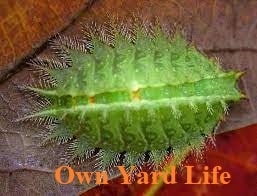
The caterpillar species belong to the same family as its saddleback counterparts. The flattened shaped and green bodies make them resemble their surroundings. The stinging spines stick out from the edges to ward off predators.
You can use the colorful spines at the head end and deep red dusty color to identify these slug caterpillars. The vibrant color usually fades to white or beige at the tail end when approaching pupation.
The caterpillar ridge has two yellow lines running up the green body and the red dots cover them. These stinging caterpillars feed on the leaves of cherry, elm, hickory, maple, oak, and prunus species.
Scientific Name |
Isa textula |
Host Plants |
Cherry, elm, hickory, maple, oak, and prunus species. |
Identification Features |
Flattened and shaped with venomous spines sticking out the edges. |
What They Turn Into |
Flatten moth with pastel green color. |
Spiny Oak Slug Caterpillar
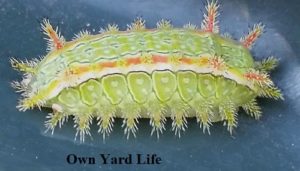
It is a type of green caterpillar with venomous spikes around the body. This bright colorful hairless caterpillar has a flattened shape and interesting marking patterns over its back.
These stinging crawling insects come in various colors like yellow, green, brown, and orange. The two orange stripes running on the back and circular lime-green markings are the distinctive features.
The bright colors and spiky appearance help ward off potential predators and human beings. Both the tufts of spines and horns on either end contain venom that can cause skin irritation.
Scientific Name |
Euclea delphinii |
Host Plants |
Apple, ash, beech, basswood, birch, blueberry, chestnut, hickory, maple, and oak. |
Identification Features |
Slightly spherical with spiny yellow horns |
What They Turn Into |
Chocolate-colored and minted green moth |
Smeared Dagger Moth Caterpillar
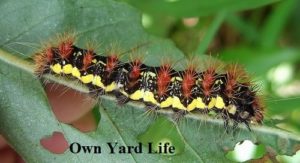
These long black caterpillars have yellow stripes and spine tufts sticking out around their bodies. A light brush against your skin could result in itchy hives and a burning sensation due to the venom.
You can identify these black and yellow caterpillars by their grayish-white or brown spines emerging from the black and white bands around their bodies. These grubs hail from Northern Canada and Southern Indiana, Texas, and Florida.
Scientific Name |
Acronicta oblinita |
Host Plants |
Clovers, apples, corn, cotton, elms, grasses, pines, and oaks. |
Identification Features |
Tufts of grayish-white or brown spines sticking out from the back. |
What They Turn Into |
Mottled grey moth |
Buck Moth Caterpillars
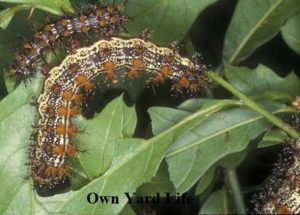
It is the spikiest larva species with jaggy dark spines sticking out from their bodies. They can grow up to 2.5 inches long and feeds on oak tree foliage. These grubs can also damage your crops and ornamental plants.
The hollow spines can transmit venom that causes a burning sensation and pain after getting the nasty sting. If small birds consume large quantities of these caterpillars, the poison can kill them.
Buck moth caterpillars are native to Louisiana and Virginia states. They love areas with a large number of oak trees and other shrubs. We recommend using chemical treatments to eliminate these grubs from your yard.
Scientific Name |
Hemileuca maia |
Host Plants |
Oak trees |
Identification Features |
Dominant black or dark brown with faint markings, tufts of spines, and jaggy venom horns |
What They Turn Into |
Black moth with narrow white bands running through the wing center. |
Monkey Slug Caterpillar
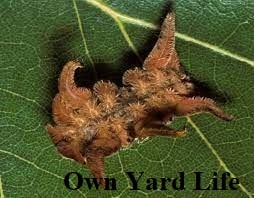
It is a unique stinging caterpillar with a brown-colored body and hairy arms that look like a squashed hairy spider. The stinging tufts of hair can cause skin irritation or allergy in some people.
Refrain from handling monkey slug caterpillars from your yard, park, and woodland forests. These caterpillars prefer feeding on the leaves of apples, birches, oaks, hickories, and chestnuts.
Scientific Name |
Phobetron pithecium |
Host Plants |
Apples, ashes, birches, chestnuts, dogwoods, hickories, and oaks. |
Identification Features |
Brown-colored caterpillar with hairy arms |
What They Turn Into |
Brown or black hag moth |
Giant Leopard Moth Caterpillar
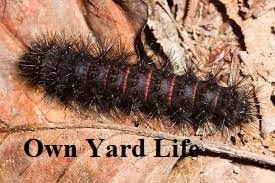
It is a fuzzy black caterpillar with red markings and belongs to the woolly bear larvae family due to its thick-looking coat. The red bands between each segment are the distinctive features for identifying these grubs.
But these red bands are visible when the giant leopard moth caterpillar rolls up into a ball to scare away potential predators. Besides that, they lack urticating spines though the pain and skin irritations come from the stiff spines.
Scientific Name |
Hypercompe scribonia |
Host Plants |
Banana, cherry, cabbage, dandelion, maples, orange, sunflowers, violets, and willow. |
Identification Features |
Fuzzy black caterpillars with stiff spines |
What They Turn Into |
White moth with black spots all over the wings |
Variable Oak Leaf Caterpillar
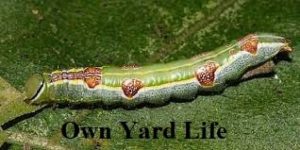
These are long yellowish-beige caterpillars with brown, yellow, and white patterns along their abdomens. These brown markings allow the grubs to camouflage in the oak barks and hide from potential predators.
The white lines running up the back and along the sides are the distinctive features for easy identification. They also have heads with black and white stripes. Besides that, their bodies are covered with a few short spines that do not sting.
But refrain from touching variable oakleaf caterpillars since they spin out acid when under threat. The acid causes skin irritation and a burning sensation that does not need medical intervention.
Scientific Name |
Lochmaeus manteo |
Host Plants |
Oaks |
Identification Features |
Long yellowish-beige caterpillar with yellow, brown, and white patterns. |
What They Turn Into |
Hairy dark grey moths |
South American Caterpillar
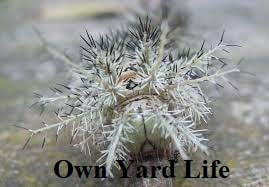
Also called giant silkworm moth caterpillar or assassin caterpillar, since it is the most toxic and dangerous species. These grubs can grow up to 2 inches long with shades of green or brown.
South American caterpillar contains urticating spines connected to poisonous glands in the body. Severe contact with these caterpillars can lead to death if not treated immediately.
These caterpillars are native to central and South America. The Lonomia obliqua and Lonomia Achelous species are deadliest than their counterparts. They turn into giant silkworm moths after pupation.
Scientific Name |
Lonomia obliqua |
Host Plants |
Deciduous trees and shrubs |
Identification Features |
Rows of tubercles with spines of different sizes. |
What They Turn Into |
Giant silkworm moth |
Hickory Tussock Caterpillar
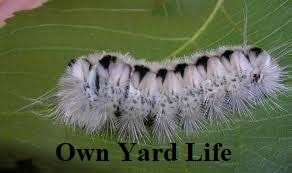
It is a black and white caterpillar covered with a tuft of hair that can irritate and cause skin rashes. These worm-like caterpillars have long white pencil hairs at both ends and black dot bands around the white body.
These poisonous caterpillars can grow up to 1.77 inches long and feed on the foliage of willows, pecans, hickories, and walnuts. Use chemical treatment to kill these caterpillars from your backyard trees.
Scientific Name |
Lophocampa caryae |
Host Plants |
Hickories, pecan, walnut, and willow trees. |
Identification Features |
White body with black dots and tufts of hairs |
What They Turn Into |
Brown moths with shades of white and ivory yellow. |
Giant Silkworm Moth Caterpillar
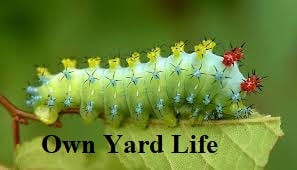
It is the deadliest caterpillar native to Brazil, Uruguay, Paraguay, and Argentina. The spikes carry venom that can cause death among humans and pets. We recommend seeking immediate medical care when stinging with 100-200 giant silkworm caterpillars.
The colors range from brown to green with different spike sizes. These poisonous grubs can grow up to 2 inches long and love feeding on the leaves of deciduous trees or shrubs in the summer.
Scientific Name |
Lonomia obliqua |
Host Plants |
Deciduous trees and shrubs |
Identification Features |
Brown to a green caterpillar with spikes |
What They Turn Into |
Brown moth with yellow feet and red spots |
White Cedar Moth Caterpillar
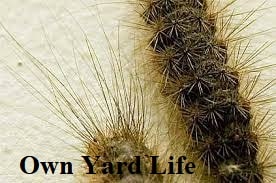
These fuzzy caterpillars are native to Australia and have a black-copper-colored head for easy identification. White cedar moth caterpillars love feeding on the leaves of Cape lilac trees in the summer through fall.
The brown-body caterpillars with uneven yellow stripes have fuzzy hairs that irritate the skin upon slight contact. These hairs contain toxic substances and can retain venom after they have been shed.
Scientific Name |
Leptocneria reducta |
Host Plants |
Cape lilac tree |
Identification Features |
Brown body with black and copper head |
What They Turn Into |
Grey-brown moth |
Laurelcherry Smoky Moth Caterpillar
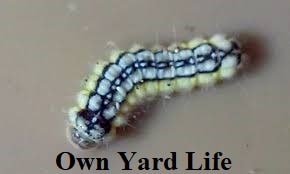
It is a short and stocky caterpillar with transparent yellow spots on the sides. The grub also has intermittent black stripes around its body. The short yellowish hairs around the body can cause pain and rashes when they come into contact with your skin.
These caterpillars have small hoods where they hide their heads when threatened. They also love feeding on Carolina laurel cherry leaves in the summer through early fall. Use insecticides to eliminate these caterpillar species in your yard or garden.
Scientific Name |
Neoprocris floridana |
Host Plants |
Laurel cherry |
Identification Features |
Short yellowish hairs and intermittent black stripes |
What They Turn Into |
Dark grey moth |
Pine Processionary Caterpillar
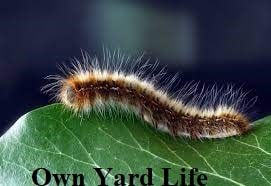
Pine processionary caterpillars are native to Southern Europe. These stinging caterpillars live in colonies and travel from one tree to another. They have green-colored bodies with yellow stripes and thin whitish spines.
These grubs feed on pine needles and each colony settles on a pine branch. Besides that, they make nests of silk threads around the pine branches. The whitish spines are dangerous for pets and can cause mild allergies in humans.
We recommend keeping your dogs away from pine processionary caterpillars when visiting France and Spain. Be sure to avoid standing under pine trees in the summer while in Southern Europe.
Scientific Name |
Thaumetopoea pityocampa |
Host Plants |
Pine trees |
Identification Features |
Green body with yellow stripes and whitish spines |
What They Turn Into |
Grey moth with white markings |
Final Thoughts from Experts
You might encounter different types of stinging caterpillars when they leave their host plants in search of a place to pupate. These creepy creatures are not aggressive and won’t come after you.
But they will drop on you from their host plant accidentally. Be alert and keep an eye on trees or shrubs with caterpillars to avoid getting stuck. Caterpillars are more prevalent in the summer, spring, and early fall.
Common host trees for stinging caterpillars are plum, oak, apple, elm, maple, basswood, cherry, and dogwood. You might also find some stinging caterpillars on corn and other crops in the garden.
We hope this information will help identify different kinds of stinging caterpillars in your backyard, park, and woodland forest. Feel free to share the article with your friends or family members.
People Who Read This Also Read:


